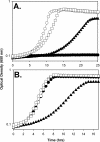Salmonella enterica requires ApbC function for growth on tricarballylate: evidence of functional redundancy between ApbC and IscU
- PMID: 18441067
- PMCID: PMC2446783
- DOI: 10.1128/JB.00262-08
Salmonella enterica requires ApbC function for growth on tricarballylate: evidence of functional redundancy between ApbC and IscU
Abstract
Mutants of Salmonella enterica lacking apbC have nutritional and biochemical properties indicative of defects in [Fe-S] cluster metabolism. Here we show that apbC is required for S. enterica to use tricarballylate as a carbon and energy source. Tricarballylate catabolism requires three gene products, TcuA, TcuB, and TcuC. Of relevance to this work is the TcuB protein, which has two [4Fe-4S] clusters required for function, making it a logical target for the apbC effect. TcuB activity was 100-fold lower in an apbC mutant than in the isogenic apbC(+) strain. Genetic data show that derepression of the iscRSUA-hscAB-fdx-orf3 operon or overexpression of iscU from a plasmid compensates for the lack of ApbC during growth on tricarballylate. The studies described herein provide evidence that the scaffold protein IscU has a functional overlap with ApbC and that ApbC function is involved in the synthesis of active TcuB.
Figures


References
-
- Bartolome, B., Y. Jubete, E. Martinez, and F. de la Cruz. 1991. Construction and properties of a family of pACYC184-derived cloning vectors compatible with pBR322 and its derivatives. Gene 10275-78. - PubMed
Publication types
MeSH terms
Substances
Grants and funding
LinkOut - more resources
Full Text Sources
Molecular Biology Databases
Miscellaneous

